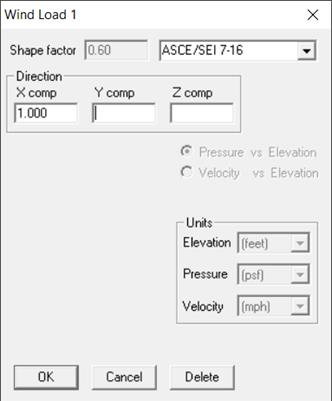Wind Load – ASCE/SEI 7-16
The determination of wind loads for the structural design of buildings is a complex subject that many building codes simplify by presenting tables of net wind pressures versus height above grade. Wind loads on a building in any particular locality depend on many factors, including recorded wind speeds in the area, the terrain around the building, and the shape and height of the building. It is now common for wind tunnel model tests to be conducted for tall buildings to determine wind loads - which may be more severe than the minimum code requirements.
American Society of Civil Engineers Standard (ASCE) SEI 7-16 contains detailed information and formulas for computing wind loads on buildings in various geographic locations. The procedure described in this code has been updated in CAEPIPE starting Version 10.30 and can be accessed through this option Layout Window > Misc > ASCE/SEI 7-16.
By defining the basic wind parameters in the dialog shown, CAEPIPE will compute the Design Wind Force internally as per ASCE/SEI 7-16 and apply the same to the piping system. For details on implementation, refer Appendix “ASCE/SEI 7-16” from Code Compliance Manual.
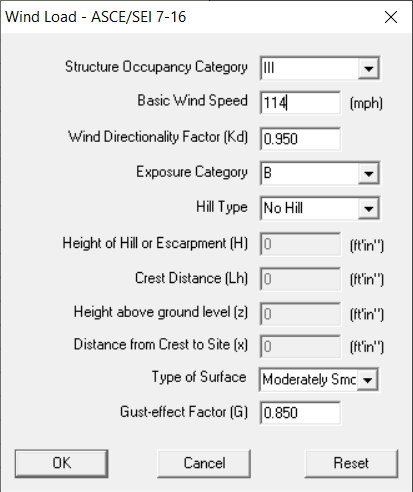
Structure Occupancy Category
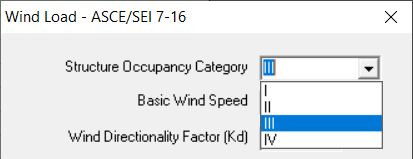
Structure Occupancy Category (Risk category) can be I, II, III or IV as provided in the Table below.
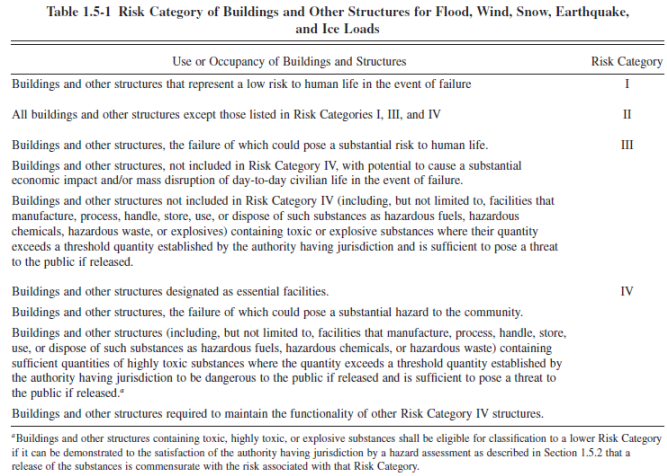
Basic Wind Speed (V)
Depending upon the Risk Category, Basic Wind Speed (V) can be determined from the Figures 26.5.-1A, 26.5-1B and 26.5-1C provided in Chapter 26 of ASCE/SEI 7-16.
For example, Basic Wind Speed (V) at Caledonia, MS (near Aberdeen, MS) with Risk Category III is 114 mph (as per Figure 26.5-1B of ASCE/SEI 7-16).
Alternatively, one can use the link https://hazards.atcouncil.org/#/ to determine the Basic Wind Speed (V) as per ASCE/SEI 7-16 by entering the location as shown below.
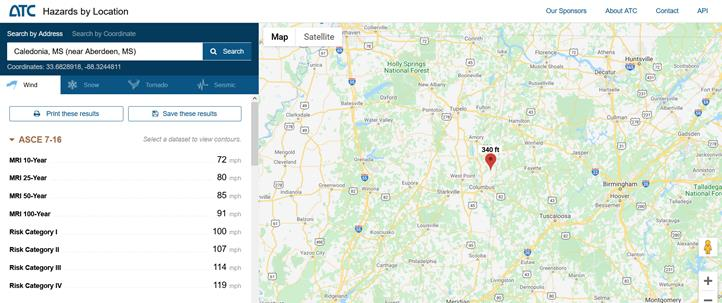
Wind Directionality Factor (Kd)
This Wind Directionality Factor (Kd) accommodates the cross-sectional shape of the structure. The wind directionality factor (Kd) can be determined from Table 26.6-1 of ASCE/SEI 7-16. This table is provided below for quick reference.
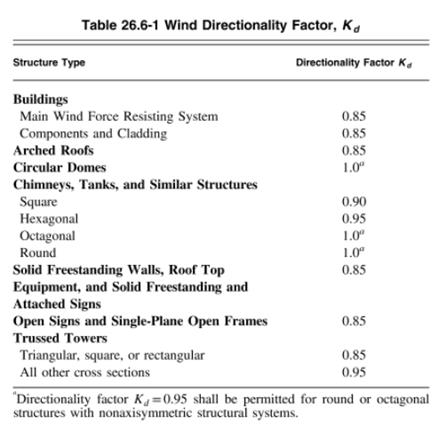
For example, Chimneys, Tanks, and Similar Round Structures, Kd = 0.95.
Exposure Category
Exposure Category can be B, C or D.
For each wind direction considered, an exposure category that adequately reflects the characteristics of ground surface irregularities shall be determined for the site at which the building or structure is to be constructed. For a site located in the transition zone between categories, the category resulting in the largest wind forces shall apply. Account shall be taken of variations in ground surface roughness that arises from natural topography and vegetation as well as from constructed features.
The exposure category for an individual structure shall be based upon the site conditions that will exist at the time when all adjacent structures on the site have been constructed, provided that their construction is expected to begin within one year of the start of construction for the structure for which the exposure category is determined.
For further details, refer para. 26.7.3 of ASCE/SEI 7-16 on Exposure Categories.
Topographical Parameters
Topography or large vertical displacements of the ground surface can have a significant effect on the wind speed profile. The wind flow in a realistic environment is not merely over a single ground feature such as hills, ridges, escarpment, but as well over undulating and mountainous terrain. It is important to understand that the flow over one hill will affect that around the next. The effects of undulating and mountainous terrain are almost similar to those of a very rough surface. Ridges and escarpments are mainly two-dimensional land feature, and hills are mainly three dimensional.
Hills differ from ridges in that the wind can diverge over sides in addition to speeding up over crests. The speed-up effects of a hill are thus generally less than that those of a ridge of the identical slope. In general, the wind increases its speed when it moves up the windward slope of a hill or a ridge. The maximum increase in wind speed is usually experienced at or near the crest.
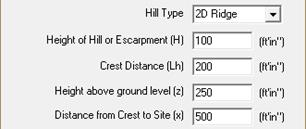
Parameters such as Hill Type, Height of Hill or Escarpment (H), Crest Distance (Lh), Height above ground level (z) and Distance from Crest to Site (x) are required by ASCE/SEI 7-16 for computing the Topographical Factor (Kzt) required in computing the Velocity Pressure (qz).
Refer para. 26.8.2 of ASCE/SEI 7-16 for more details on Topographical Parameters.
Type of Surface
Type of Surface can be “Moderately Smooth”, “Rough” or “Very Rough”. This parameter is used to compute the force coefficient (Cf) required in computing the design wind force (F).
For further details, refer para. 29.5 from ASCE/SEI 7-16.
Gust-effect Factor (G)
As per para 26.9.1, Gust-effect factor for a rigid building and other structures is permitted to be taken as 0.85.
Upon defining the above parameters, the user can apply Wind Load by selecting the wind code as “ASCE/SEI 7-16” through Layout Window > Loads > Wind1/Wind2/Wind3/Wind4.
